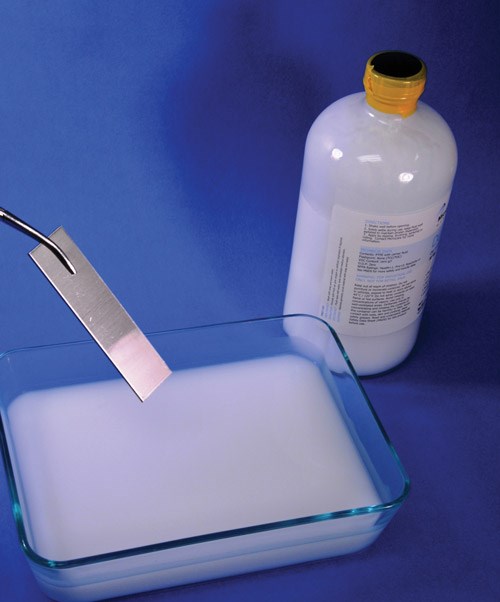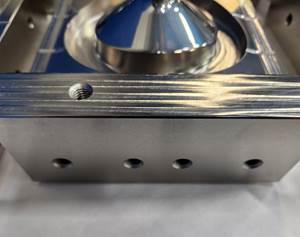Design and manufacturing engineers frequently develop medical devices that are considered complex mechanical assemblies, such as surgical staplers or other devices with multiple functions and lots of moving parts.
These designs frequently present functionality challenges that are the result of stacked tolerances, or the permissible limits of variation in a physical dimension that are specified by the design engineer to allow reasonable leeway for imperfections and inherent variability, without compromising performance of the finished assembly or process.
In the case of complex mechanical assemblies, these tolerances can “stack up” against each other and cause the device to take more effort to actuate, resulting in devices that do not operate as they were designed.
One simple solution for preventing the “stack up” of tolerances is the use of dry lubricants as a surface treatment. Dry lubricants that use PTFE technology thinly coat the surface of a finished device or mechanical assembly, reducing the extra friction caused by stacked tolerances and ensuring optimal device functionality and performance.
The Solution
One logical solution to addressing tolerance issues would be to ensure higher levels of precision in the design phase by designing everything with tighter tolerances. However, in most cases this is not a viable option. Higher precision generally means a higher cost due to more frequent inspections and maintenance of the machines and tooling during the manufacturing process that are required to maintain those high levels of precision.
So the challenge is to find a low-cost, efficient means to address tolerance issues. The use of a dry lubricant as a surface treatment often fits the bill. Dry lubricants have excellent materials compatibility and have the ability to conform to almost any surface geometry. Perhaps one of the greatest benefits of these surface treatments is that they are easy to apply in-house and incorporate into the assembly process, which further adds to their cost-effectiveness.
Especially important in the case of medical devices and manufactured parts, PTFE coatings do not migrate, meaning they will not transfer to packaging or otherwise untreated surfaces. This is in contrast to oil-based silicone coatings that readily transfer to packaging or adjacent surfaces. This transfer can compromise the later application of surface treatments such as markings or medication, or cause staining or other cosmetic issues which are unacceptable in the medical industry, where cleanliness is an essential requirement.
Additionally, PTFE surface treatments have been shown to reduce the force needed to actuate a device by as much as 30 percent in some instances.
Optimizing Your Coating Process
Not all lubricants are created equal, and not one lubricant will be right for every situation. There are considerations to be taken into account when determining a coating process that is right for a specific device or manufactured part.
Design and manufacturing engineers don’t have to worry though, as they don’t have to choose their coating system or process alone. In addition to providing the product, some coatings providers also act as consultants to ensure engineers are using the right type of lubricant and then optimizing the manufacturing process to accommodate the application.
Experienced suppliers should be asking engineers questions such as:
•What is the application or end-use of the device or manufactured part? For example, will it need topierce skin as required of surgical needles and hypodermic cannula?
•How many cycles will the part/assembly be required to operate?
•Will it need to stand up to a few cycles? A dozen? Hundreds?
•What is the geometry of the part? This can helpto determine the best application method of the lubricant.
•What are the anticipated production volumes at start up and over the long term?
Answers to these questions will help the coatings provider determine the most suitable type of lubricant. For example, if the device will be invasive, most likely a silicone-based coating will be used, as medical grade silicone has excellent lubricous properties and is widely accepted as safe for contact with human tissue. A PTFE coating will be used more often on mechanical assemblies that function outside of the body.
Knowing the number of cycles the part or device is intended to go through indicates if a more permanent coating is necessary.
The lubricant should be applied in a way that makes the most sense based on the geometry of the part, and the manufacturing volumes. Dry lubricants are easy to apply even in high-volume production environments and can be done in many different ways. When coating small parts, coils of wire and other items of varied shapes, dipping is a common method of application. Wiping or brushing is more common with parts that have continuous surfaces, such as rods, tubing or sheets.
All of these factors combine to help determine if the coating process can be done in-house. For example, the process of applying most types of PTFE dry lubricants and some silicone-based lubricants is so simple that it can be done in-house. However, more durable lubricants or those with specialized properties require more advanced application methods and may need to be applied by an experienced vendor off the manufacturing premises using highly specialized methods.
An example of this is specialized lubricants that add hydrophilic properties to treated surfaces. These lubricants create a lubricious surface that is dry in the packaging, but uses body fluids to enhance surface lubrication when the device is in-use. These coatings are more sophisticated than other types of lubricants and require special chemistries and application methods. Also, some types of PTFE-based surface lubricants need to be applied under precisely controlled thermal and atmospheric conditions to impart a more durable coating and a longer service life.
Other considerations include cost, safety, materials compatibility, floor space availability and environmental concerns. The coatings provider should be able to advise on all of these factors and counsel on general best practices.
The Bottom Line
Dry lubricants provide a cost-effective and efficient solution to address stacked tolerances. Partnering with the right coatings supplier can help to ensure that the design and manufacture of the device is done in a way that optimizes functionality and ultimately saves time and money.n
Jay Tourigny is senior vice president at MicroCare Corp. Medical. He can be reached at jaytourigny@microcare.com.





















